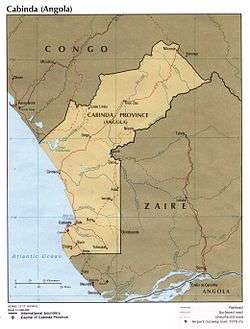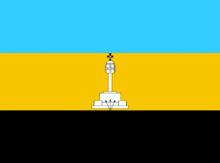Front for the Liberation of the Enclave of Cabinda

The Front for the Liberation of the Enclave of Cabinda (Portuguese: Frente para a Libertação do Enclave de Cabinda, FLEC) is a guerrilla and political movement fighting for the independence of the Angolan province of Cabinda.[1] Formerly under Portuguese administration, with the independence of Angola from Portugal in 1975, the territory became an exclave province of the newly independent Angola. The FLEC fights the Cabinda War in the region occupied by the former kingdoms of Kakongo, Loango and N'Goyo.
History
On February 1, 1885, the Treaty of Simulambuco was signed, establishing Cabinda as a Portuguese protectorate.[2][3] A monument was built there later.
In 1963, three organizations — the Movement for the Liberation of the Enclave of Cabinda (MLEC), Action Committee of the Cabinda National Union (CAUNC), and the Mayombe National Alliance (ALLIAMA) — merged to form the FLEC.[4]
The MLEC flag was yellow with a seal in the center showing the Mayombe. The leader of the united group was Luiz Ranque Franque, who refused to join other Angolan independence movements. FLEC adopted a flag with horizontal red, yellow and blue bands—one color for each of the groups. The new emblem (a white star and a green triangle within a ring) was added in the center.
During the Portuguese Colonial War (1961–1974), the nationalist movements of Cabinda fought against the Portuguese Armed Forces. After the Estado Novo regime which ruled Portugal and its overseas territories fell in the "Carnation Revolution" military coup of 25 April 1974 in Lisbon, independence was offered to all the territories abroad, including to Angola. In 1975 FLEC constituted a provisional government spearheaded by Henriques Tiago that proclaimed Cabindan independence from Portugal on August 1, 1975. Luiz Ranque was the president.
Between November 1975 and January 4, 1976, the Cabinda exclave was invaded by soldiers of the Popular Movement for the Liberation of Angola (MPLA), which was one of the dominant independence movements in Angola, supported by Cuban troops. The MPLA quickly gained control of the urban areas while FLEC controlled the countryside.


FLEC broke into three factions; FLEC-Ranque Franque, FLEC-N'Zita, led by Henrique N'zita Tiago, and FLEC-Lubota, led by Francisco Xavier Lubota. In November 1977 another faction, the Military Command for the Liberation of Cabinda, was created. In June 1979 the Armed Forces for the Liberation of Cabinda created another movement, the Popular Movement for the Liberation of Cabinda (MPLC, Movimento Popular de Libertação de Cabinda). In the 1980s FLEC received help from the National Union for the Total Independence of Angola (UNITA), which opposed the MPLA-controlled government of Angola, and from South Africa. In 1988, the Communist Committee of Cabinda (CCC, Comité Comunista de Cabinda) left the FLEC, led by Kaya Mohamed Yay. In the 1990s another faction, the National Union for the Liberation of Cabinda (União Nacional de Libertação de Cabinda), led by Lumingu Luis Gimby, was created.
The original FLEC was re-formed in the 1990s, and two factions were created; FLEC-Renovada, whose flag was white with a central stripe divided into three colors (green, yellow and black, with a red ring in the center of the flag), and FLEC-Armed Forces of Cabinda (FLEC-FAC, Forças Armadas de Cabinda), using the original red, yellow, and blue flag, with emblem.
Another group was created by Cabindese expatriates in the Netherlands in 1996, the Frente de Libertação do Estado de Cabinda" (FLEC (Lopes), Liberation Front of the State of Cabinda). This group adopted a blue, yellow and black flag with the Silambuco monument in the center.
In December 2002, Angolan Armed Forces announced the capture of FLEC-Renovada.[5] In August 2006 a ceasefire was signed between FLEC-Renovada and Angola government. This has been denounced by most Cabindan groups both inside and outside Cabinda as a sham. FLEC-FAC continues its struggle for independence both inside and outside Cabinda. In October 2006 FLEC-FAC asked for intervention by the African Union's Commission on Human and Peoples' Rights. In December 2011, the African Commission seized jurisdiction of the matter and is currently deliberating.
Factionalism
Togo football team bus attack
On 8 January 2010, while being escorted by Angolan forces through the disputed territory of Cabinda, the team bus of the Togo national football team was attacked by gunmen as it travelled to 2010 Africa Cup of Nations tournament. The ensuing gunfight resulted in the deaths of the assistant coach, team spokesman and bus driver, as well as injuring several others.
An offshoot of the FLEC claimed responsibility. Rodrigues Mingas, secretary general of the Front for the Liberation of the Enclave of Cabinda-Military Position (Flec-PM), said his fighters had meant to attack security guards as the convoy passed through Cabinda. "This attack was not aimed at the Togolese players but at the Angolan forces at the head of the convoy," Mingas told France 24 television. "So it was pure chance that the gunfire hit the players. We don't have anything to do with the Togolese and we present our condolences to the African families and the Togo government. We are fighting for the total liberation of Cabinda."[6]
Kidnappings
Starting from 2000, members of the group took some of foreign citizens hostage in Cabinda. In March 2001, FLEC-Renovada kidnapped five Portuguese employees of a construction company who were then released three months later. In May 2000, FLEC-FAC kidnapped three foreign and one local employee of a Portuguese contractor who were released in two months.[5]
External support
France has been criticized for continuous paternalistic policy of Françafrique, a network of unofficial political and commercial engagements with political and business leaders in Africa for various economic gains. One of these leaders, Henrique N'zita Tiago resides in Paris while the other, Rodrigues Mingas has been reportedly using a French cell phone although he claimed he still lived in Cabinda.
Although these special ties between French intelligence services and FLEC started during the Cold War to counter Cuban-backed Marxist regime in Angola, they continued on even after the war was over. France has also been involved in the Angolagate arms deal scandal which involved illicit weapons sales to Angola during the 27-year civil war. The President of France, Nicolas Sarkozy, claimed he wanted the Françafrique policy abolished.
France has a big interest in Angola. The French oil giant Total which made a new offshore oil discovery in October 2009, has been expanding its presence in Angola. The country is the second largest contributor for production of Total after Nigeria.[7] According to Angolan media, France and Portugal will allow extradition of leaders of the separatist movement in the wake of the 2010 attacks on Togo's football team for which FLEC claimed the responsibility.[8]
See also
- African independence movements
- Angolan Civil War
- List of active autonomist and secessionist movements
- Republic of Cabinda
References
- ↑ AlʻAmin Mazrui, Ali. The Warrior Tradition in Modern Africa, 1977. Page 227.
- ↑ UNPO Resolution Concerning the Cabinda Enclave Unrepresented Nations and Peoples Organization, July 7 2005
- ↑ Shillington K., Encyclopedia of African history, Volume 1, p197 ISBN 978-1-57958-245-6
- ↑ James, W. Martin; Susan Herlin Broadhead (2004). Historical Dictionary of Angola. p. 60.
- 1 2 Global Security. Military. Cabinda
- ↑ Sturcke, James; Myers, Paul; Smith, David (2010-01-11). "Togo footballers were attacked by mistake, Angolan rebels say". The Guardian. Retrieved 2010-01-11.
- ↑ Angela Charlton (2010-01-12). "Togo Bus Rampage Exposes France's Angola Ties". The New York Times. Retrieved 2010-01-13.
- ↑ "Portugal to hand over Cabinda separatist leaders?". The Portugal News Online. 2010-01-15. Retrieved 2010-01-15.
External links
- Kabinda Nation (Portuguese)
- FLEC Noticias (Portuguese)
- FLEC flags at FOTW
- Incidents attributed to FLEC on the START terrorism database, Profile on START